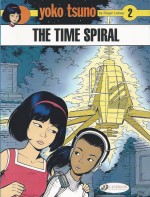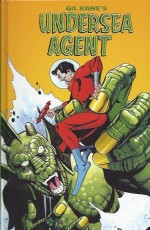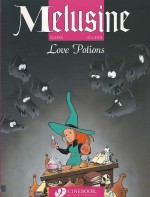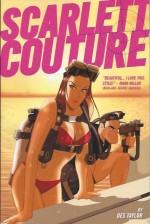
By Roger Leloup translated by Luke Spear (Cinebook)
ISBN: 978-1-905460-43-4
Arch-adventuress and scientific investigator Yoko Tsuno debuted in Spirou in September 1970 and is still going strong. As detailed by Roger Leloup, the astounding, all-action, uncannily edgy, excessively accessible exploits of the slim, slight Japanese techno-hero are amongst the most intoxicating, absorbing and broad-ranging comics thrillers ever created.
Leloup’s brainchild is an expansively globe-girdling, space-&-time-spanning series devised by the monumentally talented Belgian maestro after finishing his time as a studio assistant on Herge’s The Adventures of Tintin. Compellingly told, superbly imaginative but always solidly grounded in hyper-realistic settings underpinned by authentic, unshakably believable technology and scientific principles, his illustrated epics were the forefront of a wave of strips changing the face of European comics in the mid-1970s.
They all featured competent, clever and brave female protagonists, revolutionising Continental comics and they are as timelessly engaging and potently empowering now as they ever were.
The very first stories ‘Hold-up en hi-fi’, ‘La belle et la bête’ and ‘Cap 351’ were brief introductory – and possibly beta-testing – vignettes before the superbly capable Miss Tsuno and her valiant but less able male comrades Pol Paris and Vic Van Steen properly hit their stride with premier full-length saga Le trio de l’étrange which began in Spirou‘s May 13th 1971 issue…
In the original European serialisations, Yoko’s exploits alternated between explosive escapades in exotic corners of our world and sinister deep-space sagas with the secretive, disaster-prone alien colonists from Vinea but, for the majority of the English translations thus far, the extraterrestrial endeavours have been mostly sidelined in favour of epically intriguing Earthly exploits. That changes with this particular tale as a new thematic strand of classic sci fi endeavour is convincingly introduced…
There have been 27 European albums to date and this one was first serialised in 1980 (Spirou #2189-2210 before being released the following year as compellingly gripping thriller album La Spirale du temps. It was chronologically the 11th album, yet due to the quirks of publishing reached us Brits as Yoko’s second Cinebook outing, offering enigma and mystery and three shots of global Armageddon…
Yoko is visiting a cousin and enjoying old childhood haunts in Borneo, with Vic and Pol along for the ride and – as ever – scouting film footage for another of their documentary projects. As the boys take to the skies in a helicopter their companion is befriending elephants and exploring an ancient, ramshackle and beloved temple. She is particularly taken with the bas-relief of a beautiful dancer on the wall of the crumbling edifice which has fascinated her since her earliest years…
This night, however, her bucolic routine is shattered by a strange sequence of events. Staying out later than usual, Yoko observes a bizarre machine appear out of thin air near the temple. As a young girl steps out of the contraption she is barracked by two men, one of whom then shoots her.
Instantly Yoko intervenes but when she decks the shooter he vanishes in an explosive swirl of light. Incredible explanations follow as the girl introduces herself as Monya, a time traveller from the 39th century. It’s hard to believe but she does have a gadget which closes and repairs her wound in seconds…
Monya has come back in time to prevent a scientific experiment currently running in the area which will result in Earth’s destruction in her era. In fact, the voyager from 3872 saw her father die and the planet turn to a cinder relative moments before arriving. Now she is intent on finding scientist Stephen Webbs and stopping his imminent test of an antimatter bomb…
Taking Monya to cousin Izumi‘s home, Yoko confers with Vic and Pol, who listen with astonishment to her story of future war, a devastated ecology and the planet’s destruction and how the fourteen year old has been tasked with ensuring that her reality never comes to pass. Monya’s attacker had been a man named Stamford: a fellow time-traveller who had gone off-mission and died because of it. Chrononauts cannot exist outside their own time without biological regulators to attune them to foreign times, and he must have damaged his when he tried to kill her…
A lucky chance then points them to a remote area where an Australian named Webbs has set up a site for an international telecomms company. The next morning our heroes are heading for the Dragon Mountain in two helicopters, although they are not sure what they will do when they get there: certainly not kill Webbs as Stamford wanted…
Bluffing their way in, Yoko and Monya leave the boys in the air as back-up and quickly discover the site has precious little to do with radio communications. It’s an old Japanese fortress from WWII, reconditioned to be utterly impregnable and manned by a private army. They even have a particle accelerator…
Whatever the researchers are up to, they don’t discount Monya’s story. Too many strange things have happened lately. Webbs was acquainted with Stamford; another colleague – Leyton – has gone missing and a rash of strange events has plagued the project. Before suspicious Webbs can explain further, and as if to underscore the point, a massive piece of machinery flies across the room and almost kills the girls…
Webbs is at his wits end, but Monya’s futuristic tech detects a strange energy field and leads Yoko to another fantastic discovery. On a tunnel wall sealed for decades she reads a military warning inscription. It is signed by her uncle, Toshio Ishida. An engineer and part of the occupation forces, he stayed and married a local after the war. Yoko is staying in his home with the colonel’s son Izumi…
Webbs is desperate to talk. Taking the girls aside he reveals what Monya already knows: he has isolated antimatter. What she didn’t know, however, is that the revelation was given to him by some unknown manipulator and only he can handle the material. Everybody else is held back by the kind of force that is causing objects to fly about and explode. Most terrifying of all, Webbs has uncovered evidence that the Japanese also had antimatter. If so, why didn’t they win the war…?
With no other option available Yoko decides she and Monya must travel back to 1943 to solve the mystery…
What they discover is a viper’s nest of criminality and intrigue, a scheme to unleash hell on Japan’s democratic enemies and an arcane horror which tests Yoko’s guts and ingenuity to the limit. Moreover, even after spectacularly defeating the threat in 1943, the alien menace remembers its enemies once they return to the present…
Complex, devious and superbly fast-paced, this mesmerising thriller is an onion-skinned marvel of clever plotting: a fabulous monster-hunting yarn which reveals more of Yoko’s past as she tackles a threat to today and saves a distant tomorrow.
Building to a thundering climax and uplifting conclusion, it again confirms Yoko Tsuno as an ultimate hero, at home in all manner of scenarios and easily able to hold her own against the likes of James Bond, Modesty Blaise, Tintin or other genre-busting super-stars: as triumphantly capable facing spies and madmen as alien invaders, weird science or unchecked forces of nature…
As always the most effective asset in these breathtaking tales is the astonishingly authentic and staggeringly detailed draughtsmanship and storytelling, which superbly benefits from Leloup’s diligent research and meticulous attention to detail.
The Time Spiral is a magnificently wide-screen thriller, tense and satisfying, which will appeal to any fan of blockbuster action fantasy or devious derring-do.
Original edition © Dupuis, 1981 by Roger Leloup. All rights reserved. English translation 2007 © Cinebook Ltd.











